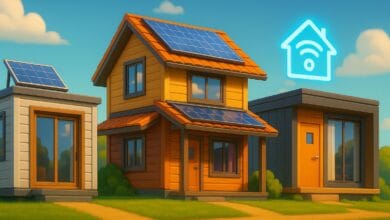Earthquake Resistance of Prefabricated Houses: Comparison of Tree House, Prefabricated House and Steel House
Since Turkey is a country located on active fault lines and frequently experiences earthquakes, the earthquake resistance of houses is of great importance. Major disasters such as the 1999 Marmara Earthquake have demonstrated the importance of the measures to be taken in this regard. Developing construction technologies enable the construction of more durable and safe structures against these threats. In recent years, prefabricated houses have become popular due to their economic advantages and rapid construction. However, the earthquake resistance of prefabricated houses is often questioned. In this section, we will discuss the earthquake resistance of prefabricated houses in detail, comparing them with wooden houses and steel houses.
Earthquake Resistance of Prefabricated Houses
Prefabricated houses are structures that are manufactured in a factory and assembled on site. These structures are usually built using durable materials such as steel, concrete and aluminum. The earthquake resistance of prefabricated houses varies depending on the materials used, building design and assembly process. However, in general, prefabricated houses are considered to be highly earthquake-resistant structures since they are produced with modern construction technologies.
Steel Frame System and Earthquake Resilience
The most widely used material for prefabricated houses is steel. Thanks to its high strength and flexibility, steel enables earthquake-resistant structures to be created. Steel skeleton helps structures gain flexibility. In the event of an earthquake, the steel skeleton system connected to the ground of the structure effectively absorbs the tremors and protects the integrity of the structure. Therefore, steel frame prefabricated houses are resistant to the effects of many different seismic effects, including large earthquakes.
Modular Structures and Flexibility
The modular structure of prefabricated houses also offers an important advantage against earthquakes. Modular structures are based on the principle that each module is designed and manufactured separately and then assembled. This flexibility allows the structure to move more during an earthquake. That is, the gaps and flexibility between the modules allow for better absorption of shaking during an earthquake. This is an important feature that increases the earthquake resistance of prefabricated houses.
Design of Earthquake Resistant Prefabricated Houses
The earthquake resistance of a prefabricated house does not only depend on the material used; it also depends on the design of the structure. The design of an earthquake-resistant prefabricated house involves many factors, starting from the foundation of the building to the correct construction of the walls and roof. The structure is designed with seismic loads in mind, with calculations made by earthquake engineers. Also of great importance are all the connections, material quality and assembly process involved in prefabricated houses. A good engineering design maximizes the earthquake resistance of the house.
In terms of earthquake resistance, steel-framed prefabricated houses can generally be designed to withstand earthquakes of magnitude 7.0. However, this durability may vary according to the quality of the material used, the soil structure of the region where it is built and engineering calculations.
Earthquake Resistance of Tree Houses
Tree houses are environmentally friendly and aesthetically preferred structures built from natural materials. However, there are some challenges regarding the earthquake resistance of wood material. Since wood is a natural material, it can deteriorate, rot and deform over time. Therefore, the earthquake resistance of tree houses varies depending on the type of wood used, the geographical conditions in which the structure is built and the design of the structure.
Flexibility and Durability of Tree Houses
Since wood is a flexible material, it is resistant to earthquakes to some extent. However, the flexibility of wooden houses is more limited than steel or reinforced concrete structures. During an earthquake, the structural systems of tree houses usually do not flex much, which can cause damage to the structure. However, the use of solid and high quality wood can make the structure more resistant to earthquake effects. However, the durability of wooden houses is generally lower compared to prefabricated and steel houses.
Insulation and Climate Challenges for Tree Houses
Tree houses can often have difficulties with insulation. Especially in humid areas, the wood material deteriorates over time and this can affect the stability of the structure. There is also a high risk that seismic movements after an earthquake will cause the structure to deteriorate and collapse. The fact that the building materials of wooden houses may lose their durability over time may reduce their safety against earthquakes. For this reason, tree houses require constant maintenance and repair to be earthquake resistant.
Earthquake Resistance of Steel Houses
Steel houses are one of the safest options in terms of earthquake resistance. Steel is a material with very high strength and is also flexible. During an earthquake, the structural systems of steel houses can be designed to withstand large tremors. Steel helps the structure to remain flexible during an earthquake and ensures that the structure is generally less damaged. When steel houses are designed in accordance with earthquake regulations, they can withstand very high earthquakes.
Durability and Flexibility of Steel Houses
The biggest advantage of steel houses is that they offer high earthquake resistance thanks to their flexible structure. Steel is highly resistant to stresses and has a high capacity to stretch. During an earthquake, steel structures can effectively absorb tremors. The flexible fasteners used in the design of steel houses ensure that the structure remains stable during shaking. Therefore, steel houses can be safe even against very severe shaking, such as earthquakes of magnitude 7.5-8.0.
Advantages of Steel Houses and Earthquake Safety
Another advantage of steel houses is that they are modular. Modular structures can be built quickly and modified when necessary. In addition, steel houses are usually lightweight, which helps them to withstand less earthquake loads. This reduces earthquake damage to the structure. Steel materials are also long-lasting and maintenance requirements are minimal. Special technologies used in the design of steel houses ensure maximum safety against earthquakes.
Conclusion
Prefabricated houses, wooden houses and steel houses, each with their own advantages, perform differently in terms of earthquake resistance. Steel houses stand out as the safest option in terms of earthquake resistance. Prefabricated houses, on the other hand, can be highly earthquake resistant with the right design and use of quality materials. Although wooden houses are preferred for their natural aesthetics, they may remain at lower levels in terms of earthquake resistance compared to other options.
When choosing a house, it is of great importance to use accurate engineering calculations and appropriate building materials to increase safety against earthquakes. Structures designed with steel, concrete and quality prefabricated materials can secure homeowners in an earthquake-prone country like Turkey.
Have you questioned the earthquake resistance of your house before building it? Have you had a technical study done?



